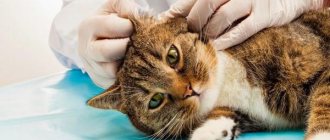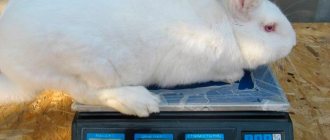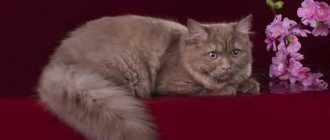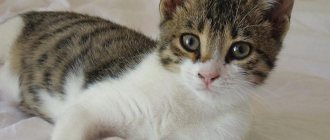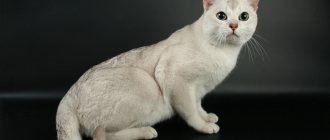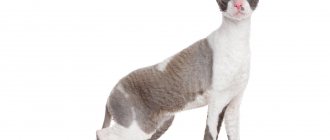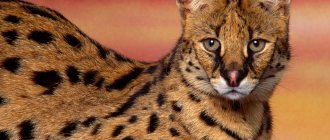Many people, when choosing a pet, are guided not only by the external characteristics of the breed, but also by the character. It is believed that representatives of ancient breeds are the friendliest, most flexible and trainable.
The Egyptian Mau has been known since the ancient kingdom. This is a graceful, intelligent animal with a unique color, bright contrasting stripes and spots on incredibly soft fur.
Video
* We invite you to watch a video about the Egyptian cat . In fact, in front of you is a playlist in which you can select and watch any of 20 videos about a given cat breed by simply clicking on the button in the upper right corner of the window. In addition, the material contains quite a lot of photos. By looking at them you can find out what an Egyptian cat looks like.
In this article:
|
Rate the material!
[Total votes: 1 Average: 5]
The Egyptian cat in ancient times was called Mau. This is a natural breed that unites the descendants of Egyptian sacred cats and street stray cats of Delhi. They resemble either motley provincial “yards” or graceful silver leopards. Looking at the Mau, you can remember the gods, pharaohs and even Queen Cleopatra.
Feeding
Like any decent battery, the Egyptian Mau has its own energy capacity. They are very active, therefore, they need to eat well. The average daily diet should be based on 80 kcal per 1 kg of weight per day.
Experts still recommend feeding Mau with dry or canned food. This is due, first of all, to their tendency to allergies.
For the Egyptian Mau, choose super premium food specially designed for this breed. Of course, the cost of such food is quite high, but the pet’s health is more expensive.
Video
Photos
An interesting fact: among all the cats, domestic and purebred, the Mau is perhaps the record holder for running. Egyptian women can reach speeds of up to 58 kilometers per hour. Photos and videos of Mau races can decorate your home album.
History of the origin of Egyptian cats
The history of the formation of the breed began about a hundred years ago, when felinologists in a number of European countries became interested in the indigenous cats of Egypt. But the Second World War put an end to their plans. The newly produced breeders of the new breed have almost completely disappeared.
A certain number of Egyptian Mau were preserved by the Russian princess Natalia Trubetskoy, who owned a nursery in Italy. She registered them with the local branch of FIFe, showing them for the first time at an exhibition in 1953. Later, moving to the USA, she organized the Fatima kennel, where she continued breeding the new breed. The founders of the nursery were cats of silver color and a bronze cat.
Egyptian cats aroused interest among the Americans, who made the most serious contribution to the selection of the breed. They took a cat from Ancient Egypt as a model, which was recreated by restorers. The basis was cats from North Africa, which were chosen for a suitable phenotype. They were crossed with similar individuals of different, but not African, origins, including the American Shorthair. The line going back to the Fatima nursery is the “traditional original line”. But it almost completely disappeared as a result of crossing with the “Indian line”.
The “Indian line” of Mau was started by Gene Mill, who in 1980 brought aboriginal cats from India, which introduced a bronze color with a clear pattern to the breed. The “Egyptian line” appeared in several nurseries thanks to the importation of stray cats from Egypt in the 80s and early 90s.
In Europe, Egyptian cats have been seriously bred since 1988 by nurseries in Switzerland, the Netherlands and Italy. But they are not very common here, since American breeders hold back their breeding animals. In Russia, the first Mau nursery appeared in 2011; now there are no more than five of them. The Egyptian Mau was recognized by the CFA in 1977, the FIFe in 1992 and several other felinological organizations.
Historical roots
The history of the breed began five thousand years ago. It was then that the wild cat of Africa, succumbing to the evolution of the species, gave birth to Nubian kittens. This happened in Egypt. This is reflected in the name of the modern descendants of the ancient species.
The formation of the breed began in Ancient Egypt. Wild cats Felis Silvestris Libyca survived by hunting mice and other small rodents. The search for prey led the spotted predators to the dwellings of the Egyptians. Settlements began to get rid of snakes and pests, for which they rightly thanked wild cats.
Later, the Egyptians discovered the peaceful nature of furry hunters. The animals turned out to be absolutely non-conflict and even calm. So, the wise and cunning cat gradually made its way into people's homes, becoming an affectionate and playful pet.
The splendor of the Egyptian exterior
However, the Egyptians were in no hurry to elevate mousecatchers to the rank of favorites. No images of mustachioed pets were found in ancient painting. Cats got a special place in paintings only hundreds of years after their domestication.
The Egyptian breed is called the ancestor of the very Nubian, which the inhabitants of Egypt called sacred. And the name “Mau” was given to the species in a completely prosaic way. This breed is very “talkative” and loves to meow with or without reason. The animals got their name from the drawn-out “ma-a-a-u” sound.
Mau - cats of the other world
The greatness of the breed is confirmed by the fact that in the 20th century, researchers managed to excavate an entire cat burial. During the New Kingdom, the temple of Bastet, the patroness of home and hearth, was located on this territory. She was depicted as a woman with a cat's head. Therefore, it is not surprising that the Egyptians decided to bury an entire battalion of cats next to their mistress.
The ancients revered cats and believed in their sacred origin. Mummies of animals were buried in the temple tombs, supposedly conveying “messages” to the goddess Bastet herself. In those days, amulets and “cat” charms were used to attract good luck in love. Clay tailed animals also protected their owner from black magic.
The ancients revered cats and believed in their sacred origin
Egyptian cat - description of the breed
According to the CFA standard, the Egyptian Mau is the only natural cat breed. Individuals are medium in size, with well-developed muscles and athletic appearance. The physical condition must be excellent, the appearance alert, the look temperamental. Males are generally larger than cats, weighing 4.5 – 6 kg.
More details:
- The head is a slightly rounded wedge of medium length. The profile is smoothed, with a slight rise from the bridge of the nose to the forehead. The length of the nose is equal to its width when viewed from the front;
- The muzzle fits into the wedge-shaped contour of the head, neither short nor sharp. The chin should be firm, not slanted or protruding;
- The ears are medium or large, moderately pointed, alert, with wide bases. The hair in the ears is short and dense. The inside of the ear is soft pink, almost transparent, and may have a tassel;
- The eyes are large and attentive, almond-shaped, somewhat slanted;
- The body is of medium length, graceful, well-developed muscles, balanced. It is acceptable for cats to have a powerful neck and shoulders. A loose fold of skin is visible from the side to the knee of the hind leg;
- Legs are proportional to the body. The hind legs are slightly longer: they give the impression that the cat is standing on tiptoes. The feet are small and graceful, slightly oval. Toes: five in front and four in back;
- The tail is of medium length, thick at the base, gradually tapering into a cone;
- The coat is short or medium length, shiny. When colored smoke, the coat is silky and has a delicate structure. Cats with silver and bronze colors have a dense, elastic, ticked coat.
Disadvantages and grounds for disqualification:
- Short or round head;
- Small, round or “oriental” eyes;
- A short or crooked tail and an incorrect number of toes are disqualifying;
- Solid lines of spotting on the body, disqualification for lack of spots;
- The presence of a white medallion or buttons that are not acceptable for this color;
- Disqualification for blue eyes and spotted or pink paw pads;
- Unhealthy looking.
How to choose a kitten
You should choose a descendant of the Egyptian Mau in a nursery, where they will be quickly socialized and handed over with all the documents.
A distinctive feature of all Mau is the “M” symbol, which appears even at an early age. Therefore, it is difficult to confuse kittens with other purebred breeds.
When choosing, pay attention to the baby’s mobility and his external condition. He must be well-groomed.
Important! Many nurseries test for the presence of a genetic disease.
Popular colors of Egyptian cats
The eye color resembles a green gooseberry and the greener the better. It is established gradually as the cat grows up: it becomes noticeable by the age of eight months and is finally formed by one and a half years.
A design on the forehead in the form of two letters “M” forming a “scarab”. The spots along the spine merge into one line, passing onto the tail. The tail has rings and its tip is black. The eye is emphasized by a line going to the ear. There may be stripes on the neck, shoulders and legs, but only spots on the rest of the body.
Three colors are allowed for a fur coat:
- Silver. Pale silver background on head, shoulders, outer legs, back and tail. The underside is lighter. All markings are dark gray on a white or grayish undercoat, contrasting. The ears at the back are greyish-pink with black tips. The upper part of the throat, chin and fur around the nostrils are light silver, almost white. The skin of the nose is brick red. The rim of the nose, lips, eyelids, soles and palms are black with black between the toes;
- Bronze. The background color is a warm bronze hue, more intense on the spine and lightening to tan on the sides. The underside is cream (ivory). All markings are dark brown with brown undercoat, contrasting. The back of the ears is flesh-colored with dark brown tips. The upper part of the throat, chin and fur near the nostrils are pale cream. The skin of the nose is brick red. The rim of the nose, lips, eyelids, and bridge of the nose are dark brown. The soles of the hind legs and palms are black or dark brown;
- Smoke. Pale silver background color on head, legs, tail and entire body, with all hairs tipped black. All markings are jet black with white or pale silver undercoat, contrasting. The top of the throat, chin and fur around the nostrils are light. The nose, lips, eyelids, mustache, soles and palms are jet black.
Black and blue colors exist in the breed, but they are not allowed to participate in exhibitions and are used only in selection.
Figures and symbols of cats in ancient epics
In all ancient legends, the cat is identified with a mystical creature. Not only in Egypt, cats were deified and considered sacred.
In China, the goddess Li Shuo was depicted in the form of this animal. She was asked for fertility.
In Japan, the strongest talisman is considered to be a figurine of a cat with a raised paw. The state believes that these animals protect human life. This statement is associated with the legend of the emperor passing by the temple. At that moment the animal raised its paw, as if inviting the master to come inside. The emperor entered the temple, and lightning struck the place where he stood. So, the animal saved the sovereign. The Japanese still give each other cat figurines as a sign of wishes for long life.
A symbol of longevity and prosperity in Japan is the figure of a cat with a raised paw.
But in Greece and Rome, felines were the personification of evil. Cats accompanied dark, evil deities, in particular the goddess Hecate.
In Europe, at first, these affectionate pets also symbolized goodness. Everything changed during the Middle Ages. Perhaps the role here was played by the increased influence of Christianity. The church considered the worship of cats to be paganism and treated them negatively. It was believed that the soul of witches inhabited the body of the animal and thus came to people to bring harm. During this period, many cats were exterminated in vain. Representatives of black and white colors were especially affected.
Character and habits of Egyptian cats
Egyptian cats seem to be shrouded in an aura of exotic charm, which gives them the centuries-old history of sacred cats. But they are quite real and have the health and lively mind of their ancestors - the street cats of Cairo and Delhi. In their elastic gait and the shimmer of their shiny skin, the image of a cheetah is visible. This is a rare and expensive breed, a symbol of prestige and prosperity.
Fun fact: Mau cats are highly intelligent and extremely loyal to their owners. These are companion cats. They love all the family members they are used to. They are careful with strangers, but in their own territory they do not show fear, only frantic curiosity.
Egyptian Mau are interactive cats. Simply put, they go everywhere, even where they don’t ask. They have very fast reflexes, faster than other cats. They ride deftly on their shoulders, can open any door, empty refrigerators, and love to wake you up in the morning if they need something. But they clearly sense the boundaries of what is permitted, and try not to run into punishment.
These are sporty cats both in spirit and in their physical make-up. They love games and hunting, where they demonstrate excellent working qualities. Remarkable hearing, vision, sense of smell, agility and speed make this cat an exemplary guardian of the house from rodent attacks. In the absence of these, she demands to be amused with toys and teases.
To irritating factors: children, dogs, other pets, treats emotionally. If they do not put too much pressure on them (literally and figuratively), then the Mau will find a common language with them on the basis of games and physical exercises. Cats are talkative, have a pleasant voice and can “sing along” with their owners.
Mau are clean and easily litter trained. They themselves do not serve as a source of pollution in the apartment, since they have short hair. Many owners note their interest in water, which they are not afraid of and can play with a stream or splashing water in a bowl.
Tips for choosing a kitten
Despite the productive work of Mau breeders around the world, purebred cats and male cats are very rare and only in professional nurseries. If you saw a handsome spotted dog on the market, don’t rush to buy it, almost one hundred percent under the bright color is hidden a yard “Murzik”, for which they want to get a lot of money.
If you have decided to acquire a rare representative of the Mau, contact only special nurseries! Sign up for the queue and wait for the kitten from the future litter.
The cubs are separated from their mother no earlier than 3 months of age, when they do not require care and can feed and walk independently. The kitten must be active, neat and well-fed. The coat should shimmer in the light, the eyes and ears should be clean.
A characteristic feature of the breed is that at two months Egyptian Mau kittens develop fuzzing - long hairs turn them into “porcupines”. But this is not a breed defect, but an intermediate stage in the formation of short hair.
Interesting facts about Egyptian cats
The name "mau" in the ancient Egyptian language meant "cat", and the sun god himself, Ra, was also called. The respect that the Egyptians had for cats is evidenced by the Sicilian historian Diodorus. In 1 B.C. A soldier in the Roman army that captured Alexandria killed a cat. The Egyptians who saw this were so enraged that, despite the threat to their own lives, they captured and executed the murderer.
Egyptian cats can reach the highest speed among all breeds - 58 km/h. For comparison, a leopard develops the same speed, a lion has 70 km/h, a tiger has 80 km/h, and the fastest mammal, the cheetah, reaches a speed of 120 km/h.
Mau have a characteristic characteristic of different cats - they touch the water before drinking. What causes this behavior is not clear. It is assumed that the cat determines the distance to the water so as not to dunk in a big way, or they like to play with the water. Or they prefer to lick water from their paws to keep an eye on those around them. But how can we explain that some people make digging movements, catching a container of water by the edges?
From 2004 to 2021 There was a public organization for the rescue of Egyptian cats (EMRO) with a shelter in Cairo. The shelter accepted Mau who were born in the Middle East with the aim of placing them in the “good hands” of different countries. The organization also engaged in educational activities, informing the population about cats in Egypt and around the world. The shelter closed when the last EMRO pet went to Germany.
Strictly speaking, EMRO cats cannot be called Egyptian Mau - they are Egyptian “nobles” without pedigrees and they are united with purebred Mau only by their region of origin. Only their fourth generation will be able to obtain purebred status and permission to reproduce in the CFA system after being assessed by experts. The second and third generations can only qualify for the pet class.
Interesting facts about the breed
Magical properties are still attributed to the Egyptian cat today. There is a ritual that allows you to fulfill seven wishes. To implement it, you need to draw a pyramid on a piece of paper and place the drawing in the center of the room.
Did you call the cat?
By summoning the mythical cat three times, you can get it to fulfill your dreams. But it’s unknown whether the cat will deign to pay attention to all those who ask.
The Egyptian Mau is a character woven from wild savannas and hot deserts. Anyone can meet a predatory soul in the guise of a cute cat. You will never be bored with such a pet, because he instantly becomes your best friend and devoted pet.
Pros and cons of Egyptian cats
Mau are very sociable cats that constantly require attention. They can be a godsend for a person who needs a companion.
In this case, all the advantages of the breed will appear:
- They happily sit on the laps and ride on the shoulders of the owner, accompanying him when moving. They are responsive to affection and care, responding with devotion and obedience;
- Mau are very friendly and sociable. They are always ready to play with toys, especially if someone takes part in their fun. They try to attract those who do not pay attention to them to the game. To win the sympathy of such a person, they pester him in every possible way and may even bring toys;
- Egyptian cats have a sweet, musical voice and sometimes walk around the house chirping or chirping like a bird. This usually happens when he/she is a happy cat or sees something particularly exciting, such as an insect.
But excessive activity and a thirst for communication can be burdensome for a person busy with his own affairs, or sick, or focused on solving problems. Due to their hectic activity, the house becomes a mess, and tidy housewives will not approve of the presence of Mau in the house.
What else is characteristic of the Egyptian breed:
- Mau, both male and female cats, often imitate marking, characteristically stomping their hind legs and shaking their tail. In this case, no marks are made. They only mislead and make the owner nervous;
- They love to tear and spoil things. House shoes that they have seen many times may be attacked. Suddenly she becomes an enemy and is seriously injured. They may sweep a cup off a table or a vase off a cabinet just to watch it fall;
- Mau are more sensitive to low temperatures than most breeds - they love warmth;
- They are more sensitive to medications and anesthesia than most cats.
Socialization and education
The breed finds the meaning of life in games. She is delicate and careful when communicating with children. However, younger household members should be instructed and the cat’s sharp claws should be clearly demonstrated to them. The Egyptian is playful, but in dangerous situations she is not used to running away. She will be defensive, so children will need tact.
Claws always ready
Communication with native breeds is based on trust and equality. The cat must respect the authority of the owner, and the owner must reciprocate. You should not expect obedience from an animal that is constantly being punished. And in order not to have to punish an adult animal, its upbringing should begin on the day it arrives at the house.
First of all, the pet is taught its name. When the kitten remembers the name, you can begin more complex lessons.
What a cat should know:
- Feeding place. The animal has lunch in a strictly designated place. Random treats from the table are excluded.
- Toilet. Fortunately, the Egyptian Mau does not have memory problems. Kittens quickly remember the location of the toilet and carefully follow the rules of hygiene.
- Charter Don't tear up the wallpaper, don't walk on the table. Without allowing any concessions, these laws can be taught to a kitten in a week or a week and a half.
The Egyptian Mau is a cunning cat. She will always test the strength of the owner's nerves. These checks will be childishly naive and gentle. It is extremely important for a wild cat to understand whether the leader has lost ground.
This breed requires not only education, but also regular communication. In order for the animal’s character to show not aggression, but innate noble traits, it needs to be dealt with. Around the first year of life, the pet will calm down its emotions and learn restraint.
This cat never gets bored
This breed is very talkative. There will be no silence in the house where the Mau lives. She voices everything that touches her quivering soul. The cat also reacts to the intonations of the human voice, skillfully imitating them.
You can admire the manner of dialogue by watching a touching story where a Mau kitten talks with “his” person:
Video - Egyptian Mau kitten
Breeding Egyptian cats
For breeding, purebred Mau are purchased with a detailed pedigree, which have genetic tests for blood type, color genes and a number of diseases. All this information helps to correctly select pairs and minimize the birth of sick and substandard offspring. It is useful for a felinologist breeder to take courses on studying cat genetics.
Examples of some patterns of inheritance:
- Bronze breeders produce bronze and black kittens;
- Smoky parents do not have silver or bronze kittens, only smoky or black;
- The black Mau appears phenotypically solid, but has a tabby genotype. The solid, even black color is due to the too dark background with which the markings merge. But they can be seen in kittens and young animals if you look closely.
Mau tolerate pregnancy well, only in the last two weeks can mood and tastes change. The expectant mother is fed more generously; you can buy special food “for pregnant and lactating” cats - they are available in the lines of many manufacturers.
A quiet corner is prepared for childbirth, but it may happen that the cat will find it in some closet. It is up to the owner to decide whether to leave it there or move it to a prepared box. Childbirth occurs without the intervention of a doctor or outside help, but the cat may want its beloved owner to support it morally - with his presence.
The gestation period of Egyptian cats lasts slightly longer than most other breeds. Kittens can appear any time between 63 and 67 days. Some cats take this matter up to 70 days and give birth to healthy kittens without any problems. Mau cats are caring mothers. Often the fathers of the kittens also help them.
Character
If the spots on the fur attract attention, then the Mau's character will attract the heart. These are tireless children, warm purrs, and in the morning - alarm clocks with rough tongues and soft paws.
Breeders describe them as extremely loyal cats, choosing one or two family members and remaining loyal and loving for the rest of their lives.
Spending time with their owner is what they love most, especially if they support games. Mau is an energetic, curious and playful cat.
Active and intelligent, Egyptian Mau need a lot of toys, scratching posts and other entertainment, otherwise they will make toys out of your things. They have strong hunting instincts; tracking and catching prey is what fascinates them.
The same applies to their toys, if you put away your favorite thing, it will be found, and then they will drive you crazy, demanding that it be returned to its place!
Like their distant ancestors who hunted birds, the Mau are fascinated by everything that moves and that can be tracked. At home these can be various artificial mice, candy wrappers, strings, but on the street they become successful hunters. To keep the cat healthy and local birds safe, it is better to keep the cat indoors and not let it go outside.
They are usually silent, but if they want something, they will give a voice, especially if it concerns food. When communicating with his loved one, he will rub against his legs and make many different sounds, such as purring, but not meowing.
The truth is that this is individual and may differ from cat to cat.
Mau like to climb higher and from there observe what is happening around them. And although they are indoor cats, they hate closed doors and closets, especially if their favorite toys are behind them. They are smart, observant and quickly understand how to get around barriers.
Many people love water (in their own way, of course), but here again, it all depends on character. Some enjoy bathing and even playing with her, others limit themselves to soaking their paws and drinking a little.
Mau get along well with other cats, as well as friendly dogs. Well, there’s no need to talk about children, these are best friends. Those who may be harmed are birds and rodents, do not forget about the hunting nature.
Caring for Egyptian cats
Caring for Egyptian cats is not specific. The main thing is that it must be regular. If a person is organized, he can include pet care into his schedule. Disorganized - just always remembers it. It is necessary to make it a rule to follow a diet and provide Mau with opportunities for physical exercise.
Given the Egyptian cat's mobility and tendency to jump, it is useful to take measures to protect against the danger of falling and injury. It is necessary to put nets on the windows or loggia to prevent them from falling out. Now there is a large selection of so-called “anti-cat nets”.
Mau must be controlled like a small child. Premises where renovations or any production work is taking place should be securely closed so that the nimble animal does not have time to escape. At any moment he can jump out the front door and find himself on a dangerous street.
You will need to carry out the following care activities:
- Combing no more than once a week;
- Teeth cleaning;
- Check the ears for debris or signs of infection. Cleaning from sulfur accumulations;
- The tray must be put in order immediately after use;
- Don't forget to supply enough water.
Simply observing your pet's behavior can reveal symptoms of health problems. Perhaps this will be a temporary phenomenon, a consequence of a simple bruise or overeating. Or the cat took it out of the garbage can and ate something inappropriate for its body.
Changes in behavior, digestive disorders, shortness of breath, lameness are not reasons to urgently fly to the veterinarian. But if they appear intensely, progress or last more than a day, then you need to consult a doctor. And we must not forget about the mandatory castration of non-breeding cats.
Care and maintenance
Short-haired Egyptian Mau are not picky about their upkeep, but rest assured: you won’t have any remorse in leaving such a charming beauty untidy. These cats do a pretty good job of grooming their own coats, but brushing the fur with an Egyptian Mau brush or mitten won't hurt. This massage will not only give your pet a neat look, but will also strengthen the hair follicles.
The breed is famous for its cleanliness, so many Mau owners do without water treatments at all (with the exception of playing with mini-waves in the bath). However, before participating in the exhibition, it is recommended to bathe your pet with cat shampoo. For silver-colored Mau, you can choose a tonic that will make the color more saturated and rid the coat of yellowness. After taking a bath - and it can last for more than an hour due to the inexhaustible love of cats for water - eliminate the source of possible drafts so that the pet does not catch a cold.
Eye care for the Egyptian Mau is minimal. Due to their specific structure, they rarely tear, and there is practically no discharge in the corners. The animal’s ears will have to be given more attention: in particular, they should be inspected once a week and cleaned with a damp cotton pad as necessary.
Egyptian Mau drinks tap water
Oral hygiene is no less important. Once or twice a month, clean your cat's teeth from plaque using a paste (you can find it at a pet store). Use a brush or attachment; in extreme cases, a finger tightly wrapped in a bandage will do. From time to time you can please your pet with special treats, which, due to their hardness, carry out preventive teeth cleaning.
To create a neat “manicure” on the paws of the Egyptian Mau, use a nail clipper. After the procedure, it is necessary to smooth out sharp edges and jagged edges using a nail file. To do this as little as possible, teach your cat to use a scratching post. Otherwise it will become a piece of furniture.
Looking at the Egyptian Mau, it is difficult to imagine that this graceful body hides a small gourmet and glutton. Representatives of the breed love to eat delicious food, so they do not control the size of portions. This responsible mission lies with the owner, who must ensure that the pet moves actively, eats in moderation and remains just as graceful.
It is preferable to feed the animal with premium food - dry or canned. Ideally, you should pay attention to options designed specifically for the breed. Egyptian Mau often suffer from food allergies, so finding the right food can take months. If you are ready to often pamper your cat with home-cooked dishes, stock up on dietary meat, sea fish, offal, seasonal vegetables and fruits, as well as sources of calcium.
Remember: it is strictly forbidden to combine two feeding options - this is fraught with problems with the gastrointestinal tract.
The Egyptian Mau should not eat:
- fatty meat (pork or lamb);
- spices (even in small quantities);
- river fish in any form;
- vegetables with a spicy taste;
- dry dog food;
- legumes;
- tubular bones;
- milk;
- liver;
- mushrooms;
- nuts.
Since these cats are very active, it is necessary to provide them with access to clean and fresh water. Mau owners recommend using bottled water, noting the fastidiousness of the “Egyptian”. Animals have inherited from their wild ancestors an instinct with which they determine whether water is suitable for consumption. To do this, the cat puts its paw into the bowl and carefully tastes the liquid.
Diet of Egyptian cats
The Egyptian cat loves to eat. Many owners make the mistake of believing that “food is love.” Such love leads to obesity and further development of appetite. The cat will constantly be in search of food of any kind. They can respond to the offered dietary food with a hunger strike and ultimately win.
When choosing a ready-made diet for Mau, pay attention first of all to food “for active cats.” If you do not overdo the dosage, Mau is unlikely to be at risk of obesity. Adult cats are given food in the morning and evening. For kittens and pregnant cats - at least 4 times a day, and for young cats - 3 times a day.
Balanced food contains mainly animal proteins (meat, poultry, fish) and up to 10% carbohydrates. The rest is various supplements to improve digestion, vitamins, minerals, omega fatty acids, taurine. The composition of “holistic” class feeds is especially diverse. Such foods imitate natural food and contain the addition of numerous herbs and vegetables, including potatoes.
When feeding natural food, lean on lean meat: chicken, turkey, beef. Optimally, meat should make up at least 70% of the diet. You can also give lamb, although it is fatty, it is considered the least allergenic. By-products are welcome, but you should not overuse raw liver, although cats are crazy about it.
Important fact: Fermented milk products and fish are required. Many people believe that fish is contraindicated for cats, but this is not true. Ready-made foods often contain it. Fish cannot be fed constantly - the synthesis of vitamin B is blocked, but periodically, three times a week, fish is useful. Another thing is that it has an unpleasant odor.
A certain amount of plant foods - vegetables, fruits and cereals is a must. Of the cereals, rice and buckwheat are the least allergenic. Wheat and corn are the most common allergens, but the cat must have a predisposition for them to be effective. A naturally healthy body uses them without any consequences.
Education and training
Egyptian cats are very smart, they have extraordinary intelligence and are very obedient. They will understand the owner practically from the first words, but it is not recommended to punish them. In mastering the rules of behavior, it is enough to talk strictly to your pet, and under no circumstances shout or hit. The animal will remember this behavior, but will not understand the reason for the owner’s aggression.
Egyptian cats are almost not touchy, but the owner’s aggression can frighten the pet for a long time
When raising a Mau, it is enough to show persistence and affection, to give the pet time to get used to it and get comfortable. The advantage of a cat of this breed is that they very well perceive a person’s tone, his facial expression and literally “read” dissatisfaction. To reinforce it, you can indicate to the animal with a prohibiting gesture, which almost always works flawlessly.
Diseases and health problems
Today's Egyptian cats have an average lifespan of about 12 years. Thanks to repeated additions of “fresh blood” from the street cat populations of Egypt, Syria and India, they have not accumulated hereditary diseases in the gene pool that are characteristic of many older breeds.
The offspring obtained from crossing producers of traditional and Indian lines, according to specially developed breeding programs, are free from a number of common feline diseases. These include: cardiomyopathy, asthma, luxating patella and dystonia, although these may occur in traditional line producers.
However, some diseases still remain:
- ICD is a disease of cats, and to a lesser extent of cats. Caused by predisposition and sedentary lifestyle;
- Renal failure is a common complication of urolithiasis, but may have an independent etymology;
- Worms and other parasites are an acquired taste, especially if the cat walks outside;
- Viral infections can be deadly for animals with reduced immunity; we must not forget about preventive vaccinations;
- Problems with teeth are rare, but Mau do have them, usually these are mechanical damage to the enamel, tartar deposits, caries;
- Feline leukemia is a viral disease that destroys the immune system; testing can detect the presence of the FeLV virus;
- Food allergies and atopic dermatitis appear in animals predisposed to them; testing for the presence of antibodies against various foods makes it possible to identify the allergen and eliminate the harmful product from the diet;
- Hyperthyroidism is an endocrine disease, a dysfunction of the thyroid gland, which manifests itself in middle and older age and often leads to heart problems.
Health of the Egyptian Mau
Kittens are resting
Spotted Cleopatras have strong immunity, so they rarely suffer from common “animal” ailments. In the middle of the 20th century, when the breed was just entering the international arena, its representatives suffered from asthma and cardiovascular diseases. However, breeders have worked hard to keep these occurrences to a minimum with each new litter. Diseases are now quite rare, but the vulnerability of the Egyptian Mau's respiratory system has not disappeared. It is strongly recommended to protect your pet from smoke, dust and strong odors.
The main scourge of the breed remains allergies. If red spots appear on your cat's body, you need to change its diet as soon as possible and consult a veterinarian for advice.
